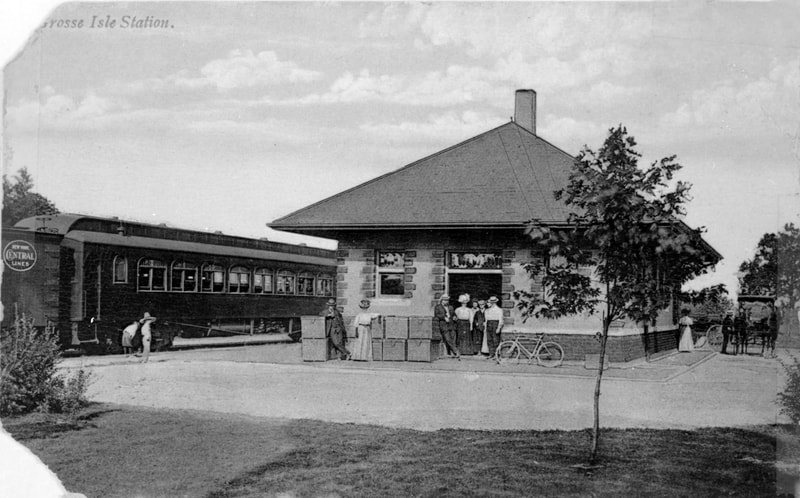The Grosse Ile Historical Society (GIHS) is a non-profit community organization committed to preserving and promoting the story of Grosse Ile, Michigan, for over 245 years. Their efforts have seen the restoration of several iconic buildings in the East River Road Historic District, such as the railway depot and former United States Customs House, St. James’ Episcopal Church, and the Grosse Ile Lighthouse. They have also established the Grosse Isle Naval Air Station Museum and installed eight Michigan Historic Site markers on the island.
The Grosse Ile Historical Society is a proud, non-profit volunteer organization dedicated to preserving and sharing the rich history of Grosse Ile. Through educational programs, events, collections, and the preservation of historical artifacts and documents, GIHS has been committed to fostering community pride and advancing knowledge of Grosse Ile’s past for over 245 years. Fundraising and volunteerism are integral to maintaining properties and exhibits, and GIHS proudly invites individuals interested in contributing to its legacy.
The East River Road Historic District is a testament to the legacy of Grosse Ile, Michigan.
It includes the Michigan Central Railroad Depot (built in 1904), the former United States Customs House (constructed about 1873), the St. James Episcopal Church Chapel (built in 1867), and six mid-19th-century homes north of the chapel.
The former railroad depot and customs house are now utilized as the Grosse Ile History Museum.
In addition to these iconic buildings, GIHS protects the Grosse Ile Lighthouse (built in 1894 and redesigned in 1906) and the Grosse Ile Naval Air Station Museum. The Grosse Ile Naval Air Station has been a key player in air activity since the mid-1920s and was a World War II training center. As part of GIHS’ commitment to preserving this history, GIHS has created a museum display within the Grosse Ile Township Hall about some of the Air Station’s historic contributions, as well as eight Michigan Historic Site markers located at various places on the island.

The Grosse Ile Historical Society also conducts outreach events and programs to ensure that people of all ages are aware of the important role Grosse Ile has played in local and national history. Through engaging exhibits, thought-provoking programs, educational newsletters, and other creative communication methods, the society strives to share Grosse Ile’s history with future generations.
The Boucher Family and Canadian Friends
Grosse Ile’s Early Firefighters
The Boucher family used these violins from 1868 to 1920, delighting audiences with their music at square dances hosted in their East River Road home. The presence of Canadian friends who joined the celebration by boat and on the ice over the Detroit River made these events even more special. Grosse Ile’s earliest firefighters also had the remarkable ability to tap into windmill power to draw river water to the island, allowing them to effectively combat fires.
During this time, the United States undertook its most ambitious and expensive project to date: a 12-mile-long Livingstone Channel widening and deepening project. Over five years, engineers built coffer dams, used dynamite to blast through bedrock and limestone, and increased the channel’s depth from 13 feet to a minimum of 22–23 feet and its width from 300 feet to a range of 450–800 feet. The successful completion of this project was a major milestone in American engineering history.
Gordon Lloyd constructed Littlecote, a Greek Revival cottage, in 1859, and it serves as an impressive example of the houses that line the historic district.
It was once home to Judge Samuel T. Douglas, an early Island resident, and was heated with a cast iron stove that arrived on Grosse Ile in 1867 aboard the side-wheeler Pearl.
The Tamarack tree section also boasts an impressive history, being part of Detroit’s first water system dating back to 1828.
In those early years, firemen had to dig a hole in the ground to reach the wooden water line before drilling a hole and using a hand pump to fill their buckets in order to put out the fires.
After the fire was out, the firemen inserted a wooden plug in the hole they had drilled and marked the location with a red stake—a “fire plug”. Thanks to their ingenuity, the next time there was a fire in the neighborhood, the firemen could quickly dig up the plug and not have to cut into the main. This simple but effective solution is a testament to the resourcefulness and dedication of firefighters.
The Grosse Ile Historical Society plays a vital role in preserving and educating about Grosse Ile’s proud history. Through its museum complexes, historic sites, and preservation efforts, GIHS is actively connecting the island to centuries of vibrant culture. By protecting these sites, collecting historical artifacts, and recreating the past through educational events, GIHS invigorates our appreciation for this much-valued destination and continues to ensure that its treasured legacy lasts far into the future.






